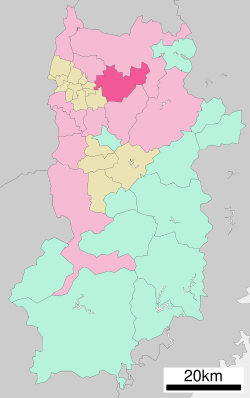Tenri, Nara
|
Tenri 天理市 |
||
|---|---|---|
| City | ||

Top left:View of Headquarter in Tenri religious community, Top right:Tenri religious school, Middle left:View of a point of side of mount Miwa road, Middle right:Stone site in Ryuo Mount Castle, Bottom:Tenri Reference Museum
|
||
|
||
 Location of Tenri in Nara Prefecture |
||
| Location in Japan | ||
| Coordinates: 34°36′N 135°50′E / 34.600°N 135.833°ECoordinates: 34°36′N 135°50′E / 34.600°N 135.833°E | ||
| Country | Japan | |
| Region | Kansai | |
| Prefecture | Nara Prefecture | |
| Government | ||
| • Mayor | Keisaku Minami | |
| Area | ||
| • Total | 86.37 km2 (33.35 sq mi) | |
| Population (April 1, 2015) | ||
| • Total | 66,866 | |
| Symbols | ||
| • Tree | Ginkgo | |
| • Flower | Ume | |
| Time zone | Japan Standard Time (UTC+9) | |
| City hall address | 605 Kawaharajō-chō, Tenri-shi, Nara-ken | |
| Website | www |
|
Tenri (天理市 Tenri-shi?) is a city located in Nara Prefecture, Japan. The modern city was founded on April 1, 1954.
As of April 1, 2015, the city has an estimate population of 66,866, and 29,169 households. The population density is 800.61 persons per km², and the total area is 86.37 km².
Tenri was briefly the capital of Japan during the reign of Emperor Ninken. The life of the Imperial court was centered at Isonokami Hirotaka Palace where the emperor lived in 488–498.
The Shinto Isonokami Shrine is in Tenri.
The central station of Tenri is Tenri Station.
...
Wikipedia


